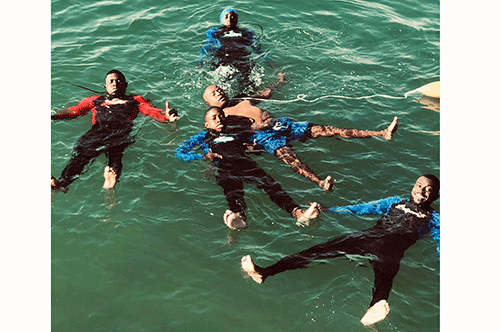Swakopmund lifeguard Jonas Sheyavali’s ultimate dream is to provide a proactive platform for young people to develop their swimming skills and play his civic duty by contributing to the reduction of drowning cases in the country, a worrisome tragedy that can be avoided.
Sheyavali (28), as a fifth grader, used to go with his friends to the sea to swim – and even though it was fun, it was also dangerous, and he recalled friends experiencing near-drowning incidents.
He told Youth Corner: “I developed a strong appreciation for life through that and realised the need to do everything we can to help those who cannot help themselves. Lifeguarding did not only help me save lives; it also helps me save my life. Having a big responsibility to serve others made me a responsible person and keep me out of the streets.
He added: “Even though we knew the risk that we will get a beating from our parents if they found out that we went swimming in the sea, punishment never stopped us from going to those swimming sessions”.
Sheyavali learned how to swim through imitation.
Growing up in Swakopmund inspired him to love swimming because heading to the beach every festive season was a norm, he said.
The aquatic man got into the industry in 2014 while volunteering at the West Coast Safety Initiative, a coastal safety company that was sponsoring the Sea Rescue Institute of Namibia.
Their coordinator, Aubrey Oosthuizen, told the young lads the reason for sponsoring sea rescue and recommended they join.
Sheyavali, who is affiliated with the Aquamund Academy, is tasked with providing swimming training to more than 100 children.
Aquamund Academy, which has nine senior members and 22 juniors, is divided into two branches to fulfil its mandate.
“Through the lifesaving services, we have a seniors’ team of seven lifeguards, who are responsible for lifesaving services. The second branch is swimming classes that consist of two coaches who are responsible for providing swimming lessons to the children. This programme is free for children in grades eight to 12, and it happens every Saturday from 13h00 to 15h00 in Swakopmund,” detailed the passionate natator.
Sheyavali said being a lifeguard for about a decade, coupled with researching aquatic education, made him to realise that the most effective way to save lives from drowning is to teach children how to swim.
“The more people know how to swim, the fewer drowning incidents we will experience as a nation. I want to see a water-love and water-capable nation, where children from all communities can enjoy water freely without the fear of drowning,” he noted. Sheyavali feels lifeguards are in high demand internationally and mostly end up working on a cruise with swimming pools or emergency services, adding that knowing how to swim also gives one an advantage in other professions, such as police, navy and water-related
professions.
Namibia this year recorded several drowning incidents, with many that could have been avoided.
The World Health Organisation (WHO) states that drowning has caused over 2.5 million deaths in the last decade, with the overwhelming majority of these deaths (90%) happening in low- and middle-income countries.
Globally, the highest drowning rates occur among children aged one to four, followed by children aged five to nine.
This year, the 76th World Health Assembly adopted its first-ever resolution on drowning prevention.
The resolution accepts the invitation of the United Nations General Assembly for WHO to organise actions within the UN system on drowning prevention and facilitate the observance of World Drowning Prevention Day on 25 July each year.


